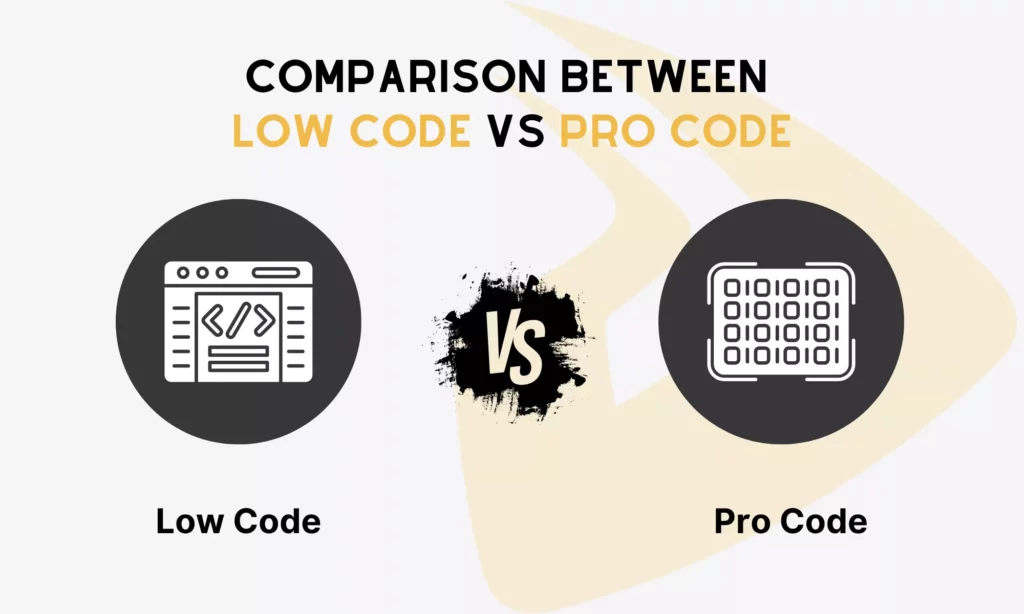These days, building software isn’t just for hardcore coders glued to their screens, running on caffeine and existential dread. Well, there are a bunch of ways to create an app, and one of them is using drag-and-drop builders, plus a bit of custom code – what we called “low code.” So, when it comes to low code vs pro code, which one’s actually worth your time? That’s what we’re digging into today.
We’re talking about what each development approach means, along with its pros, cons, and their main differences. By the end of this comparison, you’ll know which flavor fits your project. Let’s just jump in.

Understanding Low Code Development
As the name suggests, low code development refers to an approach in which you can develop software, websites, or mobile apps with minimal hand coding (called “low code”).
How? The advent of low code platforms has democratized software development.
These platforms offer a visual interface where you can use prebuilt templates and organize customizable UI components – let’s say Tables, Menus, etc. – to create the frontend of the app.
And about technical complexities like the source code behind the scenes? Don’t worry! These platforms will take care of such stuff on your behalf.
Further, they have built-in connectors to integrate with common databases and services, allowing for seamless data transfer.
They also integrate AI copilots that create apps based on your natural language descriptions.
What makes low code platforms different from no code counterparts is their code extensibility. They allow you to write custom code in the IDEs they support (like VS Code) for modifying ready-made elements or adding new features to meet your specific needs.
The rise of low code adoption is considered the top reason behind the growth of custom software development, adding 3.2% to its CAGR.
Understanding Pro Code Development
Pro code development is also called “structured coding” or “traditional software development.”
When it comes to pro code development, we often think of professional developers sitting in front of the screen and writing custom code to build software from scratch. They can create reusable code that can be put in some parts of the same software or across different projects.
However, pro code development involves no visual editors with drag-and-drop UI components.
Instead, developers use programming languages (Python, JavaScript, HTML/CSS, etc.) and frameworks/libraries to build features in their IDE terminal.
They participate in every aspect of the development cycle, from architecture planning and frontend/backend development to testing and deployment.
Key Differences Between Low Code and Pro Code
Low code and pro code development differ in the following aspects:
| Aspects | Low Code | Pro Code |
| Required Coding Skills | Limited | Specialized coding skills |
| Development Speed & Cost | Fast development + Lower costs | Less agile development + Higher costs |
| Customization & Flexibility | Lower | Higher |
| Security & Compliance | Lower | Higher |
| Scalability & Maintenance | Lower | Higher |
Required Coding Skills
While much of the technical complexity is handled by low code platforms, they still require citizen developers to know basic coding principles to write custom code.
Pro code is for professional developers who own specialized programming languages, libraries, and even advanced technologies (e.g., AI or IoT). They also need to follow best coding practices, implement development methodologies (e.g., Agile), perform thorough testing, and more to meet specific requirements.
Development Speed & Cost
With drag-and-drop UI components and prebuilt templates, low code enables fast development, as you can leverage prebuilt UI components and even AI capabilities to create apps within hours or weeks, instead of months. It also comes with lower costs due to your reliance on low code platforms.
Meanwhile, developers have to manually write, test, and optimize code from the ground up. Therefore, pro code development is less agile and slower, as well as requires higher costs to hire highly qualified talent for software creation.
Customization & Flexibility
Low code platforms take on much of the underlying code and limit you to visual components and predefined frameworks. So, they provide limited customization options to modify features for specific needs.
Besides, low code development comes with less flexibility in using programming languages and tools to build custom software.
Pro code offers higher customization, as developers have more freedom to code customized or unique features by using their favorite tech stack. Additionally, professional developers can flexibly handle and control the underlying code themselves without fear of vendor lock-in.
Security & Compliance
Low code offers lower security features than pro code. This is because the source code is hard to configure or audit for improved compliance. Meanwhile, professional developers often follow security best practices throughout development to keep their apps secure and compliant.
Scalability & Maintenance
It’s harder to scale but simpler to maintain on low code platforms due to their restrictive nature and built-in maintenance features. By contrast, pro code gives you full control over your source code, hence making your software scale and stay upgraded more efficiently.
Pros and Cons of Low Code

Many companies choose low code development because of its inherent benefits:
- Low code platforms speed up time-to-market. It helps you build simple apps or test ideas quickly by building minimum viable products (MVPs).
- It comes with low development costs. With prebuilt components and AI capabilities, you can create a simple app or automate business workflows without hiring costly development teams.
- It democratizes software and app development with a drag-and-drop visual interface. Accordingly, even when your coding knowledge is limited, you can still build software or apps without caring much about the source code.
- Low code development benefits not only novices but also seasoned developers by reducing development workloads. Professional developers can use low code platforms to create an app’s frontend by using prebuilt templates or artifacts and add customized features to align their app with their brand.
However, low code development has visible challenges:
- Low code platforms offer limited features. They only focus on several common use cases (e.g., employee onboarding) or certain industries (e.g., e-commerce). So, their feature set mainly involves corresponding topics. If you want something domain-specific (like business management software for the solar industry), they may fail to meet your needs.
- It offers limited customization options. Although it supports you in writing custom code to modify features, you can’t fully customize the source code or logic because low code platforms work under their own rules and frameworks.
- It doesn’t support full-fledged development like pro code. You may find it difficult to implement complex integrations, optimize performance, or execute advanced debugging.
- Low code platforms give you less control over security and compliance. As their providers handle most data management processes and security settings, you can hardly implement advanced security protocols or compliance measures.
Pros and Cons of Pro Code

Due to the expertise of professional developers, pro code brings lots of noticeable benefits to software creation:
- Pro code development enables you to develop more customized and complex software. While low code platforms offer sufficient features to build simple, internal apps, developers can leverage any programming language and libraries to write custom code for highly specialized or complex features.
- It gives you full control over the source code. You can easily modify the code you wrote to fix bugs or tailor functionality. This also allows your software to be polished for higher quality.
- Building new features is easier with pro code development by using your favorite tech stacks. Meanwhile, this functionality is limited to low code platforms because their vendors mainly control their underlying code.
- It improves security, performance, and scalability. Pro code development allows you to access and manage every aspect of your software, from advanced security protocols to performance optimization and data storage.
- It enables smooth integrations with unique or highly specialized systems. Low code platforms mainly support integrations with common services. If you want to connect your software with complex or unique systems, use pro code to develop custom APIs.
However, pro code development is not without limitations:
- It takes longer development time because developers have to follow best coding practices and multiple phases with thorough testing to build everything from scratch. This ensures the final deliverables will be of high quality and meet expectations but also comes with lengthy development.
- It requires higher costs associated with hiring skilled developers. If you want to integrate complex features requiring advanced technologies (like AI/ML), the labor cost may be higher.
- It’s hard to handle multiple development projects at once, as each project using traditional coding requires detailed development, careful testing, and deployment.
When to Use Low Code vs Pro Code
Given the different traits, pros, and cons, low code and pro code development proves useful in different situations.
Low code platforms work best if your company wants to:
- Build simple to moderately complex apps for internal business workflows and customer-facing scenarios
- Prototype or test ideas quickly
- Modernize legacy systems by adding extensions to your existing software
By contrast, pro code development shines if you need to:
- Create complex, enterprise-grade, or business-critical software that requires custom logic, superior security, and extensive integrations
- Develop highly customized features
- Fully control the source code for customization or debugging
- Avoid the risks of vendor lock-in or low code platforms being discontinued.
Can Low Code Replace Pro Code?

Low code cannot become a complete replacement for pro code, but a complement instead.
By nature, software or app development involves building digital solutions to handle certain problems, like creating chatbots to handle FAQs or common customer issues.
It’s not just about writing and testing code. But it also covers understanding an app’s specific requirements, designing specific architecture, managing complex logic, and ensuring software runs securely and effectively even when its user base or business demands change.
Low code platforms, along with AI copilots, assist coding by reducing manual work and speeding up delivery.
But their abilities are confined by predefined frameworks, automation, and several security settings.
They don’t offer essential tools to handle what specific scenarios or industries require, like highly tailored functionality, optimized performance, advanced security protocols, or complex integrations.
In other words, they can take care of the underlying code of common features, but they lack the ability to fully understand software architecture, nuanced UX design, and even long-term scalability.
However, pro code development can handle these requirements.
In traditional software development, professional developers can completely control architecture, logic, and other crucial factors to align the final deliverables with initial or evolving requirements.
Without being restricted within a low code platform’s available tools, developers can use any technology to build customized, secure solutions that adapt well with changing needs.
Pro code development also allows developers to understand their source code better for later troubleshooting or maintenance. This helps them build and upgrade software to always meet technical and business goals.
With these reasons, low code hardly replaces pro code. Instead, they complement technically each other to accelerate development while ensuring high quality and optimization.
How? The next section will help you discover potential scenarios where the blend of these approaches work best.
Combining Low Code and Pro Code: The Hybrid Future
Your development team can leverage both approaches in some use cases to take advantage of the speed of low code and the customization of pro code.
- Fast prototyping and custom development
Low code platforms can be used to create a prototype and test your ideas quickly. This minimum version of your software only requires adequate features to validate the feasibility of your concept rather than building a commercial solution.
Without relying on IT teams, non-technical departments or business owners can build such a proof of concept with the assistance of low code platforms.
When the basic structure is formed and the idea is proven feasible, professional developers can jump in to build more complete software. Accordingly, they can add highly customized features, optimize performance, or add features (like advanced security mechanisms or custom APIs for complex integrations) that go beyond the scope of low code.
This helps your company speed up development while making your app customized and optimized.
- Frontend with low code and backend with pro code
You can also build apps in which standardized user interfaces require low code platforms while data processing and backend integrations use pro code.
This allows you team to focus on the most critical aspects of software development and leave common tasks to low code platforms. The hybrid approach balances use of development resources (e.g., staff, tools, and budget).
Developing Professional Software with Designveloper
Low code tools are the best options if you just wanna build something fast and don’t care much about coding. But when your business needs software that actually fits, not just some generic template, you gotta call in the pros. Developers know real code, real security, and complex integrations that make a big difference for your software.
And are you looking for a reliable pro to partner with? Designveloper is here to help!
We’re the best software development company in Vietnam. For years, we’ve implemented over 200 successful projects, from healthcare to finance.

At Designveloper, we build stuff that actually clicks with whatever systems you’ve already got in place. Our impressive track record proves our excellent technical skills and deep business understanding. From ODC for remote health monitoring to Chloe Ting Hub for e-commerce and fitness blend, we’ve helped our global clients revamp their business management game.
We’re not only praised for our excellent features. But clients highly appreciate our active communication and flexible development approaches.
So if you’re thinking about leveling up what you’ve got or dreaming up something brand new, then we’ve got you. Skills, tech, all of it. Drop us a line and let’s see what we can build together.


